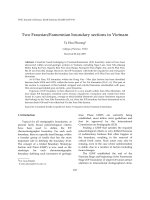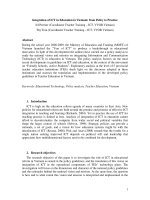Famennian boundary sections in Vietnam
Bạn đang xem bản rút gọn của tài liệu. Xem và tải ngay bản đầy đủ của tài liệu tại đây (520.92 KB, 8 trang )
<span class='text_page_counter'>(1)</span><div class='page_container' data-page=1>
187
Two Frasnian/Famennian boundary sections in Vietnam
Ta Hoa Phuong*
<i>College of Science, VNU </i>
Received 02 July 2007
<b>Abstract.</b> Conodont fossils belonging to Frasnian/Famennian (F/F) boundary interval have been
discovered within several geologic sections in Vietnam, including Ngoc Lam, Xom Nha (Quang
Binh), Kang Ka Pass, Nguom Kim Pass (Cao Bang), Noong De Pass (Nghe An), and Si Phai Pass,
Ma Pi Len Pass (Ha Giang). However, the F/F boundary with both the <i>linguiformis</i> and <i>triangularis</i>
conodont zones that bracket the boundary has only been identified at Si Phai Pass and Xom Nha
Mountain.
At Si Phai Pass, F/F boundary within the Dong Van ‐ Nho Que Section has been identified
between beds S12/8 and S12/9, within the lower part of Toc Tat Formation (D3‐C1 <i>tt</i>). This part of
the section is composed of thin bedded, stripped and colorful limestone interbedded with pure,
thin and average bedded grey and pink ‐ grey limestone.
Exposure of F/F boundary is best observed in a cave mouth within Xom Nha Mountain. All
four major F/F boundary conodont zones <i>rhenana, linguiformis, triangularis </i>and<i> crepida</i> have been
found in a grey and dark‐grey, average to thick bedded limestone and clayey limestone sequence
that belongs to the Xom Nha Formation (D3<i>xn</i>). Here the F/F boundary has been determined to lie
between beds 9‐3b and 9‐4a within bed 9 in the Xom Nha Section.
<i>Keywords:</i> Conodont fossils; <i>Linguiformis</i> Zone; <i>Triangularis</i> Zone; Frasnian; Famennian.
<b>1. Introduction*<sub> </sub></b>
Typical for all stratigraphic boundaries, at
present fairly broad paleontological criteria
have been used to define the F/F
chronostratigraphic boundary. For each such
boundary, there is a specific fossil lineage, within
a broader group of fossils that has the most
important role in defining the boundary level.
The concept of a Global Boundary Stratotype
Section and Point (GSSP) is now used as the
stratotype for each chronostratigraphic
boundary defining each increment of geologic
_______
*
Tel.: 84‐4‐8544423. E‐mail:
time. These GSSPs are currently being
established, must follow strict guidelines and
first be approved by the International
Commission on Stratigraphy (ICS).
Finding a GSSP that satisfies the required
paleontological criteria is very difficult because
of sedimentary hiatuses that often happen at
the boundary, resulting in the removal of
critical fossil zones. Such zones may also be
missing, even in the case where sedimentation
is stable, due to a number of factors including
facies changes.
The GSSP established the end of the
</div>
<span class='text_page_counter'>(2)</span><div class='page_container' data-page=2>
<i>Ta Hoa Phuong / VNU Journal of Science, Earth Sciences 23 (2007) 187‐193 </i> <sub>188</sub>
due to many important events, and sudden
changes happened in organisms living at that
time. Criteria defining the F/F boundary and
location were approved by the ICS, placing the
boundary within the Upper Coumiac quarry in
the southeastern Montagne Noire region,
Southern France. The GSSP point agreed upon
by the Subcommission on Devonian
Stratigraphy (SDS)<i> </i> corresponds to the first
occurrence of the conodont <i>Palmatolepis</i>
<i>triangularis</i>, within the <i>Palmatolepis</i> lineage, and
defines the base of the Famennian [12, 13].
Conodont zonation places the boundary
immediately following the end of the
<i>linguiformis </i>Zone<i> </i>and at the beginning of the
<i>triangularis</i> Zone<i> </i>[1]. The <i>linguiformis </i>Zone is a
relatively new conodont zone that now replaces
the upper part of the no longer used <i>gigas </i>Zone,
with the rest of the <i>gigas</i> Zone now placed
within the <i>rhenana</i> Zone. As a consequence of
this change, the Upper Devonian for F/F
boundary interval, from the uppermost
Frasnian to the lowermost Famennian includes
<i>rhenana, </i> <i>linguiformis, </i> <i>triangularis, </i> <i>crepida </i>
conodont zones, respectively (Table 1).<i> </i>
Our work on Upper Devonian sections
from Viet Nam has concentrated on the F/F
boundary interval [4, 8‐11]. As a result, abundant
conodont assemblages have been found within
this interval. However, <i>Palmatolepis</i> <i>triangularis</i>,
the critical index species defining the beginning
of the Famennian was commonly found, while
species typically used to define the <i>linguiformis</i>
Zone are relatively rare and only found at a few
localities (Table 1). Perhaps this is a result of
local facies control on the environment in which
these conodonts live.
<b>2. Frasnian/Famennian section interval in Si </b>
<b>Phai Pass </b>
This interval is belonging to the longer
section from Nho Que River to Dong Van
(Dong Van District, Ha Giang Province). It
extends from the public cistern of Si Phai
Village to Si Phai Pass. The lowermost part of
this interval is characterized by grey limestone
interbedded with argillaceous shale, thin to
medium bedded limestone, siliceous limestone
and chert with thickness of about 40 m regarded
by Dang Tran Huyen [2] as the uppermost part
of Si Phai Formation. This part of section
contains numerous tentaculites Homoctenus
and conodonts belonging to varcus, cristatus,
disparilis, and transitans zones. Overlying on
the above mentioned rocks are the first
limestone layers of the Toc Tat Formation that
composed of thin bedded stripped, variegated,
interbedded with medium bedded limestone
(15‐40 cm) greenish and pinkish grey limestone.
Table 1. Conodont zones within the frasnian/famennian boundary interval
from the Dong Van and Xom Nha sections
Stage International standard
conodont zones
Conodont zones discovered
at Dong Van Section
Conodont zones discovered
at Xom Nha Section
<i>rhomboidea </i> <i>rhomboidea </i> <i> </i>
<i>crepida </i> <i> </i> <i>crepida </i>
Famennian
<i>triangularis </i> <i>triangularis </i> <i>triangularis </i>
<i>linguiformis </i> <i>linguiformis </i> <i>linguiformis </i>
<i>rhenana </i> <i> </i> <i>rhenana </i>
<i>jamieae </i> <i> </i> <i>jamieae </i>
Frasnian
</div>
<span class='text_page_counter'>(3)</span><div class='page_container' data-page=3></div>
<span class='text_page_counter'>(4)</span><div class='page_container' data-page=4>
<i>Ta Hoa Phuong / VNU Journal of Science, Earth Sciences 23 (2007) 187‐193 </i> <sub>189</sub>
From limestone of the lower part of the Toc
Tat Formation, the collected conodont
assemblage belonging to <i>rhenana</i> and <i>triangularis</i>
zones are as follows [11]:
1) <i>Rhenana</i> Zone containing <i>Palmatolepis </i>
<i>subrecta</i> Miller & Youngquist; <i>Pa. ljaschenkoae</i>
Ovnatanova; <i>Pa. jamieae</i> Ziegler & Sandberg;
<i>Pol. </i> <i>uchtensis</i> Ovnatanova & Kuzmin; <i>Pol. </i>
<i>lodinensis</i> Polsler; <i>Ancyrodella nodosa</i> Ulrich &
Bassler; and <i>Pol. brevilamiformis</i> Ovnatanova.
2) <i>Triangularis</i> Zone containing <i>Palmatolepis </i>
<i>triangularis</i> Sannemann; <i>Pa. superlobata</i> Branson
& Mehl; <i>Pa. clarki</i> Ziegler; <i>Pa. delicatula delicatula</i>
Branson & Mehl; <i>Pa. delicatula protorhomboidea</i>
Sandberg & Ziegler; <i>Pa.</i> cf. <i>regularis</i> Cooper;
and <i>Pa. clarki</i> → <i>Pa. minuta</i>, <i>Pa. minuta minuta</i>
Branson & Mehl.
Fig. 1. The F/F boundary in the Si Phai
Mountain Pass Section.
Recently, in limestone layers that originally
are thought to belong to the upper part of the
<i>rhenana</i> Zone [10, 11], we have found the species
<i>Palmatolepis </i> <i>linguiformis </i> (S12‐6, S12‐7, S12‐8
samples), the diagnostic species for the <i>linguiformis </i>
Zone. As a result, it is now clear that within this
section, the F/F boundary interval includes two
main diagnostic conodont zones, the<i> linguiformis</i>
Zone (highest zone in the Frasnian) and the
<i>triangularis</i> Zone (lowest zone in the
Famennian). These zones cover two continuous
layers (in beds S12‐8 and S12‐9) at the lowest
part of the Toc Tat Formation (Fig. 1, 2).
Fig. 2. Stratigraphic columns of the F/F boundary
interval at Si Phai Pass and Xom Nha sections.
<b>3. Frasnian/Famennian section interval in Xom </b>
<b>Nha Mountain </b>
The section is located just inside the front
entrance of a southwestern facing cave near the
hamlet of Xom Nha (Fig. 3, 4). Carbonate layers,
mainly limestone, at this section belong to the
Xom Nha Formation (D3 <i>xn</i>). Until recently,
</div>
<span class='text_page_counter'>(5)</span><div class='page_container' data-page=5>
section. A minor but interesting Frasnian‐
Famennian assemblage of stromatoporoids and
conodonts was first discovered here by Nguyen
Huu Hung et al [5]. Therefore, for detailed
study on this boundary interval, numerous
limestone samples were collected bed by bed
for conodont study with the aim to resolve the
stratigraphical sequence of the section.
Fig. 3.<i> </i>The position of Xom Nha Section in the West
of Quang Binh Province.
The stratigraphic sequence and conodont
composition in the limestone from the bottom
to the top of the section (Fig. 4, 6) are as follow:
1. Lowermost beds are composed of grey,
dark grey limestone, thick and medium bedded
(20‐60 cm) with dimish layer surface, 1.45 m
thick. Conodont comes only from the upper
part of beds, belongs to the lower part of the<i> </i>
<i>rhenana</i> Zone, and are numbered as 1 and 2 in
Fig. 3. They include <i>Ancyrodella nodosa</i> Ulrich &
Bassler; <i>A. </i> <i>ioides</i> Ziegler, <i>Ancyrognathus </i>
<i>triangularis</i> Youngquist; <i>Palmatolepis </i> <i>rhenana </i>
<i>rhenana</i> Bishoff; <i>Pa. rhenana nasuta</i> Muller; <i>Pa. </i>
<i>hassi</i> Muller & Muller; <i>Pa. jamieae</i> Ziegler &
Sandberg; and <i>Pa. foliacea</i> Youngquist (X1, X2).
2. Medium‐bedded (20‐75 cm), fine grained
limestone, intercalated with argillaceous
limestone. Abundant conodont occurs from the
<i>rhenana</i> Zone to <i>crepid</i>a Zone, and from bottom
to top. They are as follows:
Fig. 4.<i> </i>F/F boundary lying in the middle of bed 9,
Xom Nha Section.
<i> </i>
Fig. 5. Cross section of bed 9 indicating the plates
used for conodont analysis. The F/F boundary lies
</div>
<span class='text_page_counter'>(6)</span><div class='page_container' data-page=6>
<i>Ta Hoa Phuong / VNU Journal of Science, Earth Sciences 23 (2007) 187‐193 </i> <sub>191</sub>
‐ <i>Palmatolepis rhenana rhenana</i> Bishopff, <i>Pa. </i>
<i>jamieae</i> Ziegler & Sandberg (X3); <i>Ancyrodella</i>
<i>nodosa </i> Ulrich & Bassler, <i>Pa. hassi</i> Muller &
Muller, <i>Pa. </i> <i>boogaardi</i> Klapper & Foster, Pa.
<i>juntinaensis</i> Han, <i>Pa. </i> <i>hassi</i> Muller & Muller,
<i>Ancyrodella nodosa</i> Ulrich & Bassler (X4, X5, X6);
<i>Ancyrodella nodosa</i> Ulrich & Bassler, <i>A. ioides</i>
Ziegler, <i>Palmatolepis boogaardi</i> Klapper & Foster,
<i>Pa. rhenana rhenena</i> Bischopff (X7).
‐ <i>Palmatolepis </i> <i>linguiformis</i> Muller, <i>Pa. </i>
<i>rhenana </i> <i>rhenana</i> Bischoff, <i>Pa. </i> <i>rhenana </i> <i>brevis </i>
Ziegler, <i>Pa. rhenana nasuta</i> Muller, <i>Pa. </i> <i>gigas</i>
Miller & Youngquist, <i>Pa. </i> <i>subrecta</i> Miller &
Youngquist, <i>Pa. </i> <i>hassi </i> Muller & Muller, <i>Pa. </i>
<i>juntinaensis</i> Han, <i>Pa. ederi</i> Ziegler & Sandgerg,
<i>Pa. </i> <i>eureka</i> Ziegler & Sandberg, <i>Palmatolepis </i>
<i>foliacea</i> Youngquist, <i>Ancyrodella nodosa</i> Ulrich &
Bassler, <i>A. ioides</i> Ziegler, <i>Homoctenus</i> sp. (X8);<i> </i>
<i>Pa. rhenana rhenana</i> Bischoff, <i>Pa. rhenana nasuta</i>
Muller, <i>Pa. </i> <i>gigas</i> Miller & Youngquist, <i>Pa. </i>
<i>subrecta</i> Miller & Youngquist, <i>Pa. linguiformis</i>
Muller, <i>Ancyrodella </i> <i>nodosa</i> Ulrich & Bassler,<i> </i>
<i>Palmatolepis triangularis</i> Sannemann (X9).
‐ <i>Palmatolepis triangularis</i> Sannemann, <i>Pa. </i>
<i>subperlobata</i> Branson & Mehl, <i>Icriodus alternatus</i>
Branson & Mehl. (X10, X11, X12).
‐ <i>Palmatolepis triangularis</i> Sannemann, <i>Pa. </i>
<i>subperlobata</i> Branson & Mehl, <i>Pa. delicatula</i> <i>clarki </i>
Ziegler, <i>Pa. </i> <i>delicatula </i> <i>postdelcatula</i> Schulke,
<i>Icriodus alternatus</i> Branson & Mehl (X13, X14).
‐ <i>Palmatolepis triangularis</i> Sannemann, <i>Pa. </i>
<i>triangularis </i> →<i> </i> <i>crepida</i>, <i>Pa. </i> <i>triangularis </i> →<i> </i>
<i>tenuipunctata</i>, <i>Pa. subperlobata</i> Branson & Mehl,
<i>Pa. </i> <i>delicatula </i> <i>platys</i> Ziegler & Sandberg, <i>Pa. </i>
<i>werneri</i> Ji & Ziegler, <i>Pa</i>. <i>delcatula postdelicatula</i>
Schulke, <i>Pa. weddigei</i> Ji & Ziegler<i>, Pa. minuta </i>
<i>loba</i> Helms, <i>Pa. </i> <i>quadrantinodosalobata</i>
Sannemann, <i>Pa. regularis</i> Cooper, <i>Pa. crepida, </i>
<i>Ancyrolepis </i>sp., (X15, X16, X17, X18, X19).
From the above mentioned conodonts and
their location in the section, the following
remarks can be maked for defining F/F
boundary at Xom Nha Mountain:
1. Seven lowermost beds in the section
(from sample X1 to X7, Fig. 4) contain
conodonts belonging to the <i>rhenana </i>Zone. The
conodonts in the first and second beds belong
to the lower <i>rhenana</i> Subzone, while those from
beds 3 to 7 belong to the upper<i> rhenana</i> Subzone.
2. In bed 8, <i>Palmatolepis linguiformis</i> Muller –
principal index species for the <i>linguiformis</i> Zone
was also found together with those found in the
<i>rhenana</i> Zone.
3. In bed 9, conodonts of the both
<i>linguiformis</i> and <i>triangularis</i> zones were found.
Apart from conodonts found in the <i>linguiformis</i>
Zone, the principal index species for the
<i>triangularis</i> Zone ‐ <i>Palmatolepis triangularis</i> was
also found.
4. From bed 10 to bed 14, although fossils
are rare, but <i>Pa. triangularis</i> was found in each
beds.
5. Beds 15 to 19 contain conodonts belonging
to the uppermost part of the <i>triangularis</i> Zone as
well as the whole <i>crepida</i> Zone<i>. </i>
These results indicate that the F/F boundary
at Xom Nha Section is located within bed 9. For
a better definition of the boundary, a block
containing bed 9 (33 cm thick) was cut into 12
small plates (2.5 cm for each) with corresponding
labels from the lowermost to the uppermost
plates: 9‐1a, 9‐1b ,9‐2a, 9‐2b, 9‐3a, 9‐3b, 9‐4a, 9‐
4b, 9‐5a, 9‐5b, 9‐6a, 9‐6b (Fig. 5). These plates
were used for conodont extraction, and in
plates from 9‐1a to 9‐3b, different species of
conodonts belonging to Frasnian were found,
including <i>Pa. hassi</i> Muller & Muller, <i>Ancyrodella </i>
<i>nodosa</i> Ulrich & Bassler, <i>Pa. linguiformis</i> Muller,
etc. However, from plate 9‐4a and upward, the
individuals of <i>Pa. </i> <i>triangularis</i> Sannemann
species were discovered, but the number of
individuals of different conodont species
decreased quickly. In the beds next to bed 9,
along with <i>Pa. triangularis</i> Sannemann, <i>Icriodus</i>
sp. and other conodonts of Famennian age were
also found. Therefore, the F/F boundary has
</div>
<span class='text_page_counter'>(7)</span><div class='page_container' data-page=7>
Fig. 6. Detailed stratigraphic column of the F/F
boundary interval at Xom Nha Section.
<b>4. Conclusions </b>
The F/F boundary in Vietnam has been
found at 2 places: the Si Phai pass interval within
Dong Van ‐ Nho Que Section (Ha Giang), and
in a cave mouth near Xom Nha (Quang Binh).
At Si Phai Pass, the F/F boundary has been
defined between beds S12/8 and beds S12/9,
which are belonging to the lower part of the
Toc Tat Formation (D3‐C1 <i>tt</i>). This interval is
composed of thin bedded, stripped and
variegated limestone beds interbedded with
pure, thin and medium bedded grey and pink ‐
grey limestone.
The best locality for the F/F boundary is
near Xom Nha in Xom Nha Mountain. The
major conodont zones bounding the boundary,
<i>rhenana, </i> <i>linguiformis, </i> <i>triangularis </i> <i>and </i> <i>crepida</i>
zones, have been found in grey and dark‐grey,
medium to thick bedded limestone and
argillaceous limestone that belong to the Xom
Nha Formation (D3 <i>xn</i>). The F/F boundary is
placed in the middle of bed 9, between plates 9‐
3b and 9‐4a in the section.
Paleontological characteristics and continuity
of the sedimentary environment in the F/F Si
Phai and Xom Nha boundary sections show
that those sections are more close to the
Coumiac stratotype in France [3] than to the
Steinbruch Schmidt hypostratotype in
Germany. In the last section, the change of the
sedimentary environment related to the
Kellwasser event is distinctly pronounced [6].
<b>Acknowledgements </b>
This paper was completed within the
framework of Fundamental Research Program
funded by Vietnam Ministry of Science and
Technology. The author would like to thank his
colleagues Nguyen Huu Hung, Doan Nhat
Truong (Institute of Geology and Mineral
Resources), Pham Huy Thong (Geological
Mapping Division of North Vietnam), Nguyen
Thuy Duong, Nguyen Thanh Lan (College of
Science, VNU) for their cooperation during this
study. The author expresses his deepest
acknowledgement to Prof. B.B. Ellwood
(Louisiana State University, USA) for his help
in editing the English text, and to Prof. Tong
Dzuy Thanh (Vietnam National University,
Hanoi) for improving this paper.
<b>References </b>
[1] J.W. Cowie, W. Ziegler, J. Remane, Stratigraphic
Commission accelerates progress, 1984 to 1989,
<i>Episodes </i>12 (1989) 79<i>. </i>
</div>
<span class='text_page_counter'>(8)</span><div class='page_container' data-page=8>
<i>Ta Hoa Phuong / VNU Journal of Science, Earth Sciences 23 (2007) 187‐193 </i> <sub>193</sub>
<i>Geology </i>142 (1979) 22<i> </i>(in Vietnamese).
[3] C. Girard, G. Klapper, R. Feist, Subdivision of
the terminal Frasnian <i>linguiformis</i> conodont
Zone, revision of the correlative interval of
Montagne Noire Zone 13 and discussion of
stratigrapphically significant associated
trilobites, in <i>Understanding Late Devonian and </i>
<i>Permian‐Triassic </i> <i>Biotic </i> <i>and </i> <i>Climatic </i> <i>Event: </i>
<i>Towards an Intergrated Aproach</i> <i>(Edited by D.J. </i>
<i>Over, J.R. Morrow and P.B. Wignall), </i>Elsevier,<i> </i>
2005<i>.</i>
[4] Nguyen Cong Thuan, Ta Hoa Phuong, New
data on the age of the base of Toc Tat Formation
in Ha Lang area, Cao Bang Province, <i>VNU </i>
<i>Journal of Science, Natural Sciences and Technology </i>
No. 3 / XVIII (2002) 87 (in Vietnamese).
[5] Nguyen Huu Hung, Pham Kim Ngan et al.,
Discovering the Frasnian ‐ Famennian limestones
(Upper Devonian) in Quy Dat area, Binh Tri
Thien, <i>Journal of Earth Sciences </i>4/2 (1980) 27<i> </i>(in
Vietnamese).
[6] E. Schindler, Event‐stratigraphic markers within
the Kellwasser Crisis near the Frasnian/Famennian
boundary (upper Devonian) in Germany,
<i>Palaegeography</i>, <i>Palaeoclimatology, </i> <i>Palaeoecology </i>
104 (1993) 115<i>.</i>
[7] Ta Hoa Phuong, New discovery of Devonian
and Lower Carboniferous pelagic fossils in
Dong Van area (Ha Giang Province, Vietnam)<i>, </i>
<i>Proceedings of the Int. Symp. on Strat. Correl. of </i>
<i>Southeast Asia, Bangkok </i>(1994) 62<i>. </i>
[8] Ta Hoa Phuong, Doan Nhat Truong, Preliminary
studies on the boundaries of Famennian stage in
Vietnam, <i>Journal of Geology, series B </i>5‐6 (1995) 94
(in Vietnamese).
[9] Ta Hoa Phuong, Nguyen Huu Hung, Upper
Devonian Frasnian/Famennian boundary in the
Xom Nha limestone, Quy Dat area, Quang Binh
Province, <i>Journal of Geology </i>238 (1997) 5 (in
Vietnamese).
[10] Ta Hoa Phuong, Devonian and Carboniferous
stratigraphy in Dong Van Section, Ha Giang
Province<i>,</i> <i>Journal of Geology </i>Special Issue (2000)
2 (in Vietnamese).
[11] Ta Hoa Phuong, Devonian and Carboniferous
conodont biostratigraphy of Dong Van Section, Ha
Giang Province, <i>Journal of Geology, series B </i>19‐20
(2002) 14 (in Vietnamese).
[12] W. Ziegler, G. Klapper, Stages of the Devonian
system, <i>Episodes </i> <i>(International </i> <i>Geosciene </i> <i>News </i>
<i>Magazine) </i>2/8<i> (</i>1985) 15<i>. </i>
</div>
<!--links-->









